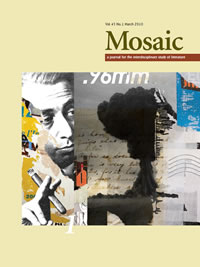Issue 43.1
Overview

General Issue
Published: March 2010
View the issue introduction or see the issue summary and contents below.
10 essays, totalling 192 pages
$19.95 CAD
This is a richly interdisciplinary issue: ten essays that bring literary-critical insights to bear on comics, film, fiction, music, vocality, phonography, photography, cartography, psychology, phrenology, and history of science. From Brokeback Mountain to “The Fall of the House of Usher,” from postcards to poetics, this is an issue to read and enjoy.
Love’s Letter Lost: Reading Brokeback MountainAndrea D. Fitzpatrick Informed by Roland Barthes’s A Lover’s Discourse, this essay considers visual and linguistic strategies in the film and the short story versions of Brokeback Mountain in order to explore key narrative figures—the loop, the postcard, the memorial, and the address—and how they convey affect in love and loss. | |
Creative Listening: Poetic Approaches to MusicJean L. Kreiling A selective survey of poems inspired by specific pieces of music reveals a variety of poetic techniques that communicate the perceptions of notably creative listeners. The attentive reader of such poetry may discover a distinctive layer of poetic meaning, a fresh perspective on the musical work in question, and a new appreciation for the intersections between music and poetry. | |
The Metropolitan as Master Subject: Janet Flanner’s “Paris Letters”Jeffrey Gonzalez Janet Flanner’s early “Paris Letters” invite the New Yorker’s audience to view Paris with condescension. The content and rhetoric of these pieces reverse the traditional hierarchy between French and American cultures, showing her readers that superiority means seeing as the master subject—a seductive perspective for an economically emergent readership. | |
Phrenological Allegory in Poe’s “The Fall of the House of Usher”Brett Zimmerman Previous allegorical readings of Poe’s “The Fall of the House of Usher” ignore the important “knowledge frame” he applied: phrenology. While we can use this pseudoscience to explain character behaviour, it is also the key to the allegory: Roderick represents a hypertrophied organ of Ideality, the narrator Adhesiveness (Friendship), and Madeline a distempered organ of Amativeness (Sex). | |
“How Good It Is to Be a Monkey”: Comics, Racial Formation, and American Born ChineseMin Hyoung Song Gene Luen Yang’s American Born Chinese demonstrates the difficulty of following the development of Asian American racial formations. It does so through the skilful use of its medium, comics, prompting readers to consider how much the meaning of race has changed, in what ways, and where this change might lead. | |
Life Forms: Elizabeth Bishop’s “Sestina” and DNA StructureJanine Rogers Elizabeth Bishop’s “Sestina” embodies ideas about heredity that circulated after the discovery of the DNA double helix, a scientific event that caused radical shifts in cultural conceptions of genetics, family, and identity. This reading synthesizes her poetics with cultural contexts, including biography, psychology, and the history of science. | |
Unsounded Vocality: The Trope of Voice and the Paradigm of Orality in American Postmodern FictionSalwa Karoui-Elounelli Arguing that the paradoxical nature of the vocal notion and of the model of oral performance in narrative fiction is further accentuated in postmodern American narrative, this essay examines some of the implications of such accentuation for poetics and aesthetics. | |
Christina Stead and the Politics of Covert StatementMichael Ackland This essay seeks to modify the notion of Stead as an intrepid, forthright writer, as well as to contribute to the ongoing reappraisal of her ideological position, by demonstrating her previously unremarked interest in, and use of, subtexts and covert statement during the Popular Front and Cold War periods. | |
The Phonograph and the Modernist NovelAngela Frattarola By examining the many striking similarities between the art of phonographic recording and the modernist novel, this essay considers how this new auditory technology functioned as a model for modernist writers, and, in changing auditory perception, impacted the ways in which these novelists represent sound and subjectivity. | |
A Defiant Cartography: Linda Hogan’s Solar StormsGeoffrey Stacks The cartographic contest between the governments and the inhabitants of the American-Canadian boundary waters plays out not only on the land itself but also on the body of the narrator, Angel. Her healing thus allows for the possibility of a defiant cartography that resists rather than supports colonization. |